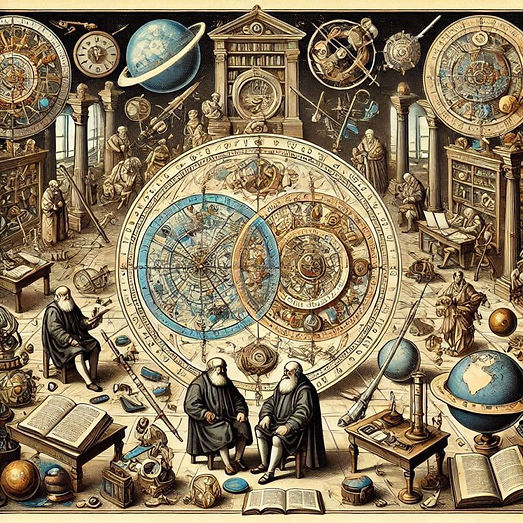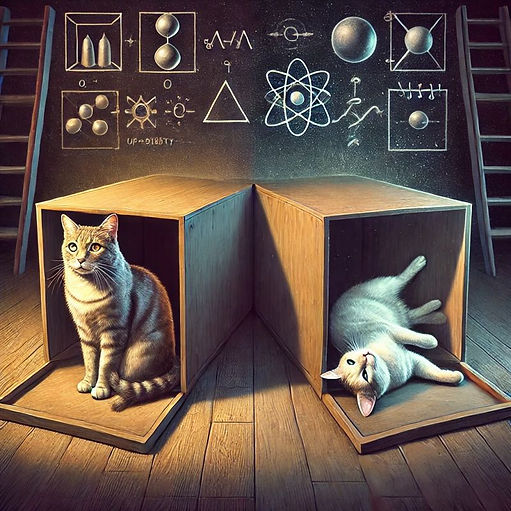Why It Is Wrong To Say That Qubits Are "0 And 1 At The Same Time"
In this post, I will explain why interpreting a qubit as a quantum system that is both 0 and 1 at the same time is incorrect.
I understand that this is an attempt to convey a difficult concept (quantum superposition) in simple terms.
However, this description is misleading and perpetuates a misconception about the quantum world: that it is a superposition of classical worlds.
This misunderstanding leads to inaccurate statements in quantum computing, such as "a quantum computer tries all possible solutions at once and chooses the correct one."
On a grander scale, some people claim "there are infinite universes at the same time."
Superposition of Motion in Classical Mechanics
Consider a projectile launched at an angle between zero and ninety degrees with respect to the ground.
In his "Dialogue Concerning Two New Sciences," Galileo explained that the motion of the projectile can be described as two independent motions: horizontal and vertical.
Using a Cartesian coordinate system with the x-axis along the ground level and the y-axis vertical, the position of the projectile over time can be expressed as functions of these coordinates.
The projectile's position is given in terms of time, so the horizontal and vertical motions are also functions of time.
It is natural to say that the particle moves "at the same time," or "simultaneously," in the x and y directions.
In modern vector notation, the position vector at any time t is given by:
V(t) = [ v_x(t) v_y(t) ]^T
This isn’t how things work in the quantum world.
Two Quantum States at Once
Richard Feynman believed that the double-slit experiment "has in it the heart of quantum mechanics."
This experiment, also discussed by David Bohm and John Bell to explore the core ideas of quantum mechanics, was popularized by Feynman in his Lectures on Physics.
It has become a foundational thought experiment for introducing quantum concepts to the general public.
It is used by everyone attempting to explain quantum superposition, from enthusiasts to experts.
I suppose that you are familiar with it.
Pay close attention, as the following argument is fundamentally flawed.
It is claimed that, since photons behave according to quantum mechanics and produce an interference pattern on the screen, the only possible logical conclusion is that they pass through both slits simultaneously.
It is thus natural to mathematically describe their state as a superposition of both possibilities, ∣u⟩ and ∣l⟩:
∣ψ⟩=½ ∣u⟩+½ ∣l⟩ .
If the probabilities of passing through the slits are not equal, maybe because one slit is slightly bigger than the other, this is generalized to
∣ψ⟩=α_u ∣u⟩+α_l ∣l⟩ ,
where ∣α_u∣^2 and ∣α_l∣^2 represent the probabilities of passing through the upper and lower slits, respectively.
Photons are, thus, described as being in a superposition of states, namely, passing through both slits simultaneously.
This mathematical framework also applies to other quantum two-level systems, such as qubits.
If a classical bit represents a state of information with values b=0 or b=1, a qubit is a quantum system that exists in a superposition of both states simultaneously, ∣0⟩ and ∣1⟩,
∣q⟩=α_0∣0⟩+α_1∣1⟩ .
More complex systems, such as Schrödinger's cat, can also be described using this principle.
Before opening the box, Schrödinger's cat exists in the state:
∣cat⟩=α_a ∣a⟩+α_d ∣d⟩ ,
where ∣a⟩ and ∣d⟩ represent the "alive" and "dead" states, respectively.
Similar to the motion of a projectile, the states of photons, qubits and cats are described as simultaneously occupying two incompatible states.
The only thing that is correct in this argument is the math.
The physical interpretation is incorrect—at least from the point of view of quantum mechanics!
What Quantum Mechanics Really Tells Us
There is almost no physicist or quantum computing expert who, when talking to non-experts, does not introduce a qubit by saying that it is a quantum system in two classical states, 0 and 1, at the same time.
Previously, I have explained the classical origin of this misinterpretation.
Let me now explain how physicists are introduced to two-level quantum systems.
The approach is historical and within the context of quantum physics.
We learn that two German physicists, Otto Stern and Walther Gerlach, studied the behavior of narrow beams of silver atoms passing through non-uniform magnetic fields.
They discovered that, regardless of the magnet's orientation, the spots on the screen indicated that the beam split into two distinct parts (instead of a continuous beam ranging from maximum to no deflection).
They concluded that this was due to the intrinsic magnetic moment (the spin) of the single electron in the silver atoms, which had two opposite discrete values, say + and -.
Associated with these values are two vectors, denoted |+⟩ and |-⟩, respectively.
Mathematically, the state of the electron before measurement is described by the vector:
|e⟩ = a |+⟩ + b |-⟩ ,
where a and b, the so-called probability amplitudes, are complex numbers.
These quantum numbers are not arbitrary; they must satisfy the experimental results.
The fact that a and b are complex numbers is the crucial difference between quantum and classical two-level systems.
As quantum numbers, they can be written as complex exponentials, and the phase difference between them plays a crucial role in the system's "coherence".
Something that does not occur in classical physics.
For example, this explains the interference pattern of electrons and photons in the double-slit experiment.
Notice that there is no mention of time, let alone "in two states at the same time" or "simultaneously."
The description is purely mathematical!
Just like in linear algebra, when we say that a vector A is the sum of vectors B and C, we do not say that A is simultaneously B and C.
The same holds for quantum mechanics.
The description is purely mathematical!
We are taught that quantum mechanics only tells us about the measurement probabilities, not about what happens between the preparation of the quantum system and the measurement.
There are some things in the quantum mechanical way of describing the world that are simply "unspeakable", as John Bell put it.
This is what is amazing about quantum mechanics, not that the qubit is 0 and 1 at the same time or that the electron passes through both slits in the double-slit experiment.
If you do not accept this, you will not be able to understand the true nature of paradoxes like Schrödinger's cat and Einstein's "spooky action at a distance".
Want to dive deeper? My eBook is a great place to start → https://www.ozatp.com/qaf


